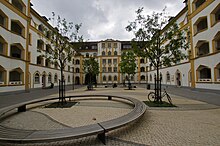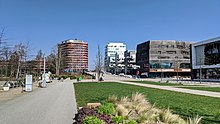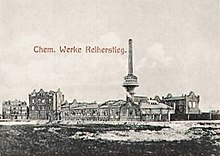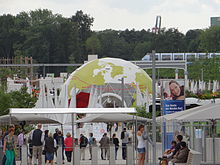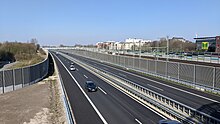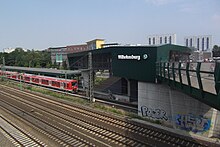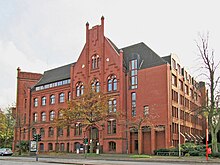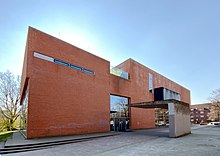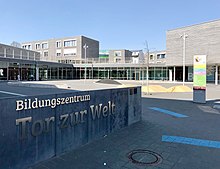Hamburg-Wilhelmsburg
|
Wilhelmsburg district of Hamburg |
|
|---|---|
| Coordinates | 53 ° 29 '42 " N , 10 ° 0' 40" E |
| surface | 35.3 km² |
| Residents | 53,518 (Dec 31, 2019) |
| Population density | 1516 inhabitants / km² |
| Post Code | 20539, 21107, 21109 |
| prefix | 040 |
| district | Hamburg-center |
| Transport links | |
| Highway |
|
| Federal road |
|
| Train |
|
| bus | |
| Source: Statistical Office for Hamburg and Schleswig-Holstein | |
Wilhelmsburg ( Low German : Willemsborg ) is a district in the Hamburg-Mitte district of the Free and Hanseatic City of Hamburg . Wilhelmsburg is Hamburg's largest district in terms of area and has the fifth largest population after Rahlstedt , Billstedt , Eimsbüttel and Winterhude . Until February 29, 2008, Wilhelmsburg was part of the Harburg district .
Geographical location

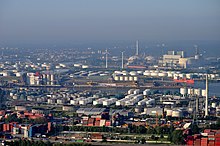
Wilhelmsburg is - together with the districts of Steinwerder , Kleiner Grasbrook and Veddel - in the "river splitting area" between the two large Elbarmen Norderelbe and Süderelbe - Köhlbrand . Popularly, these areas are often viewed and referred to as a large contiguous Elbe island, but in fact they consist of a large number of smaller islands and peninsulas.
The Wilhelmsburg district includes the main island of the same name, which in turn was created in the 18th century through dykes from several small islands ( Stillhorn , Georgswerder , Moorwerder ), the Hohe Schaar island and part of the Neuhof island .
Wilhelmsburg borders in the north on the districts Steinwerder , Kleiner Grasbrook and Veddel , in the east on Rothenburgsort , Spadenland and Ochsenwerder , in the south on Neuland , Harburg and Heimfeld and in the west on Moorburg and Altenwerder . In the far south-east, at the Bunthäuser Spitze , Wilhelmsburg also borders the Lower Saxony municipality of Seevetal .
The total area between the Norder- and Süderelbe / Köhlbrand covers about seven by seven kilometers, i.e. a good 50 square kilometers. The Wilhelmsburg district accounts for around 35 square kilometers, the main island of the same name is around 25 square kilometers.
Spatial structure
Due to its history, Wilhelmsburg does not have a grown center, but is divided into very different and sometimes far apart areas:
- The Reiherstiegviertel in the north-west emerged from 1880 as a commercial and workers' residential quarter close to the harbor and for a long time formed an urban center in the otherwise still rural Wilhelmsburg.
- The west of the district ( Neuhof , Hohe Schaar , eastern Reiherstiegufer ) consists of extensive industrial and port areas.
- The former island of Georgswerder in the northeast, Stillhorn with Kirchdorf in the south and Moorwerder in the far southeast are still predominantly rural and characterized by small-scale development. Some of the large housing estates east of the S-Bahn station and in Kirchdorf-Süd that have been built since the 1970s still form a strong contrast to their rural surroundings.
- Two busy traffic axes in the center of the island (railway line and Wilhelmsburger Reichsstraße ) still form a dividing aisle between the quarters. Since the beginning of the 2000s, this area has been reorganized as part of the International Building Exhibition and International Garden Show 2013 held at the same time ("New Center Wilhelmsburg"): For this purpose, the Wilhelmsburger Reichsstraße was relocated 400 meters to the east to the railway line and the space that was freed up for new residential quarters ( Spreehafenviertel , Elbinselquartier , Wilhelmsburger Rathausviertel ) and green areas ( Wilhelmsburger Inselpark ) are used.
history
The Elbe island landscape was created at the end of the Vistula Glaciation about 11,700 years ago, when the last Holstein glaciers melted and left a sea of small and large islands between the Geestrands in the north and south of today's Hamburg urban area. People have settled here since the 14th century - coming from Spadenland in the Vierlanden - initially on terps or sausages, artificial mounds of earth that were protected from flooding . Summer dykes protected the fields. In 1672 Georg Wilhelm von Braunschweig-Lüneburg-Celle acquired three large Elbe islands, which were connected by connecting dikes and henceforth bore the name "Wilhelmsburg". The Georg-Wilhelm-Straße is reminiscent of the former founders.
After the annexation of the Lower Elbe region by France , Wilhelmsburg was a canton in the Hambourg arrondissement of the Elbe estuary between 1811 and 1814 , then again part of the Kingdom of Hanover , which became a Prussian province after the defeat in the German War in 1866 .
After Hamburg joined the German Customs Union in 1888 and the associated expansion of the Port of Hamburg , numerous new docks, canals, roads and bridges, factories and tenements, a freight station, the Wilhelmsburg industrial railway and the Reiherstieg district as a workers' residential area near the port were built on the Prussian side . The first large-scale industrial operation was the Hamburg wool combing company, which had around 1,000 employees as early as 1890. Almost half of them were immigrants from West Prussia and Posen .
In 1925 Wilhelmsburg was detached from the Harburg district and raised to the status of an urban district (independent city). In 1927 it was combined with the neighboring Harburg to form the city of Harburg-Wilhelmsburg . Through the Greater Hamburg Law , Harburg-Wilhelmsburg was initially incorporated as a city into the State of Hamburg with effect from April 1, 1937, and in 1938 it was also formally incorporated.
In 1951 Wilhelmsburg became part of the Harburg district . The Elbe island was hit particularly hard by the storm surge in 1962 : of 315 fatalities in the whole of Hamburg, 222 were to be mourned in Wilhelmsburg alone, especially in the Reiherstieg district and a makeshift housing estate on Klütjenfeld's main dike .
On March 1, 2008, Wilhelmsburg was spun off from the Harburg district and assigned to the Hamburg-Mitte district .
population
overview
The Wilhelmsburg population is made up as follows (data from the North Statistics Office, as of December 2018):
- Total population: 54,068 people (Hamburg: 1,891,810 people).
- Minority rate: 20.6%, well above the Hamburg average of 16.4%.
- Share of households with children: 22.8%, well above the Hamburg average of 17.8%.
- Elderly rate (65-year-olds and older): 13.5%, well below the Hamburg average of 18.1%.
- People with a migration background: 60.4%, is well above the Hamburg average of 35.5%.
- People with a migration background (under 18 years of age): 78.2%, well above the Hamburg average of 52%.
- Proportion of foreigners: 32.2%, is well above the Hamburg average of 17.3%.
- Share of benefit recipients according to SGBII (Hartz IV): 20.6%, is well above the Hamburg average of 9.9%.
- Unemployment rate: 8.4%, well above the Hamburg average of 4.8%.
Wilhelmsburg is one of the less affluent districts of Hamburg. The average annual income per taxpayer was around 21,890 euros in 2013 and is significantly lower than the Hamburg average (39,054 euros).
Population development
The following overview shows the census results of the municipality of Wilhelmsburg according to the respective territorial status. With the merger with the then city of Harburg in 1927 to Harburg-Wilhelmsburg, the population of the community exceeded the limit of 100,000 and made it a major city. At the census on June 16, 1933, the city had 112,593 inhabitants. Since January 1, 1938, it has been part of the city of Hamburg. From 1890 the population figures refer to the "local population" and from 1925 to the resident population .
In 2016, 20.9% of the population was younger than 18 years (Hamburg: 16.2%), 60.4% had a migration background , among young people this figure was 78.9% (Hamburg: 34.1 and 50.4%).
| Reference date year |
Residents |
|---|---|
| December 1, 1890 | 8,800 |
| December 2, 1895 | 12,772 |
| December 1, 1900 | 16,640 |
| December 1, 1905 | 22,359 |
| December 1, 1910 | 28,225 |
| December 1, 1916 | 26,369 |
| December 5, 1917 | 25,380 |
| October 8, 1919 | 28,402 |
| June 16, 1925 | 32,517 |
| year | 1987 | 1988 | 1989 | 1990 | 1991 | 1992 | 1993 | 1994 | 1995 | 1996 | 1997 | 1998 | 1999 |
| Residents | 44,047 | 44,477 | 45,636 | 46,686 | 46,876 | 47,523 | 47,729 | 47,670 | 47,772 | 47,604 | 47,256 | 46,280 | 46.110 |
| year | 2000 | 2001 | 2002 | 2003 | 2004 | 2005 | 2006 | 2008 | 2009 | 2010 | 2011 | 2012 | 2013 |
| Residents | 46.125 | 47,180 | 47,857 | 47,847 | 48,322 | 48,957 | 49.132 | 49,803 | 50.091 | 50,472 | 50,731 | 51.171 | 52,372 |
| year | 2014 | 2015 | 2016 | 2017 | 2018 |
| Residents | 52,892 | 53,764 | 55,074 | 54,169 | 54,068 |
politics
For the election to the citizenry and the district assembly , Wilhelmsburg belongs to the constituency of Billstedt-Wilhelmsburg-Finkenwerder . The township elections since 1966 have had the following results:
| Citizenship election | SPD | Green 2) | Left 1) | CDU | AfD | The party | FDP | Rest |
|---|---|---|---|---|---|---|---|---|
| 2020 | 43.1% | 18.1% | 17.2% | 6.6% | 6.1% | 2.4% | 2.2% | 4.2% |
| 2015 | 48.2% | 11.3% | 14.8% | 9.0% | 6.8% | 3.7% | 6.2% | |
| 2011 | 53.2% | 8.1% | 10.8% | 15.3% | - | 3.4% | 9.2% | |
| 2008 | 43.6% | 5.6% | 8.7% | 35.6% | - | 2.6% | 4.8% | |
| 2004 | 35.5% | 6.1% | - | 43.0% | - | 1.6% | 13.8% 3) | |
| 2001 | 36.2% | 3.4% | 0.3% | 19.1% | - | - | 2.1% | 38.9% 4) |
| 1997 | 41.8% | 6.7% | 0.4% | 25.6% | - | - | 1.8% | 23.7% 5) |
| 1993 | 47.7% | 7.2% | - | 17.5% | - | - | 2.4% | 25.2% 6) |
| 1991 | 59.4% | 3.3% | 0.2% | 28.0% | - | - | 2.6% | 6.5% |
| 1987 | 58.4% | 3.6% | - | 33.5% | - | - | 2.9% | 1.6% |
| 1986 | 55.7% | 5.8% | - | 34.3% | - | - | 2.3% | 1.9% |
| Dec 1982 | 65.7% | 3.9% | - | 28.3% | - | - | 1.3% | 0.8% |
| June 1982 | 56.3% | 4.9% | - | 33.3% | - | - | 3.5% | 2.0% |
| 1978 | 66.7% | 2.1% | - | 26.5% | - | - | 2.5% | 2.2% |
| 1974 | 60.5% | - | - | 29.0% | - | - | 7.1% | 3.4% |
| 1970 | 68.0% | - | - | 24.1% | - | - | 3.2% | 4.7% |
| 1966 | 72.4% | - | - | 21.5% | - | - | 3.3% | 2.8% |
1) 1991 and 1997 as PDS / Linke Liste, 2001 as PDS.
2) 1978 as a colorful list - defend yourself , 1982 to 2011 as GRÜNE / GAL.
3) Including 8.2% for ProDM / Schill .
4) Including 34.9% for the Schill party .
5) Including 10.9% for the DVU .
6) Including 11.6% for the Republicans and 5.5% for the Statt Party .
The Hamburg-Mitte district assembly has set up the Wilhelmsburg-Veddel regional committee for the districts of Wilhelmsburg, Kleiner Grasbrook , Steinwerder and Veddel .
Culture and sights

Cultural institutions
- The honey factory is a cultural center that emerged in 1979 from the youth center movement.
- The Bürgerhaus is an event center.
- The Soul Kitchen event hall , known from the film of the same name , has been a venue for concerts, art and socioculture since 2010.
- The Rialto Lichtspiele , cinema / theater built in 1913, which was reopened for one summer on May 3, 2013 after being vacant for over 25 years. In addition to film screenings, readings, theater performances and concerts were also held here. The cinema was demolished in 2017 and replaced by a new building.
- The WCW Gallery , which sees itself as a non-commercial hybrid of exhibition space, gallery and work of art.
- Museum Elbinsel Wilhelmsburg eV, founded in 1907 in the Wilhelmsburg town hall. It is located in the old Hanoverian administrative building from 1724 in Kirchdorf and was built on the foundation walls of the "Noble Seat Stillhorn" from 1620.
Buildings
- The Johanna windmill and the Elbinsel Wilhelmsburg ev museum are located in Kirchdorf
- The former Groß Sand water tower is located at the hospital of the same name .
- There is an anti-aircraft bunker from the Second World War on Neuhöfer Strasse .
- Since the end of the 19th century, a road bridge has linked the districts of Wilhelmsburg and Hamburg-Harburg across the Süderelbe . In 1937 a new building was inaugurated next to it, which was supposed to relieve traffic. The new bridge structure is 470 m long with a span of 410 m, 17.5 m wide and 3300 tons of steel were used for it.
Churches and mosques

- In Wilhelmsburg there are the three Evangelical Lutheran churches Emmauskirche (former Reiherstieg Church ), Kreuzkirche and St. Raphael (Wilhelmsburg-Bahnhof), the Roman Catholic Church of St. Bonifatius and several free church communities. The former church of St. Maximilian Kolbe has been used by the Order of Malta since 2015 . The Paul Gerhardt Church was de -dedicated in 2019 and will be replaced by residential buildings.
- The six local mosques are Saidi Nursi Mosque, Ayasofya Camii , Muradiye Camii , Wilhelmsburg Camii , Yeni Cami , Fatih Camii .
graveyards
- Evangelical cemetery of the Kreuzkirche Kirchdorf
- Evangelical cemetery Wilhelmsburg (de-dedicated)
- Friedhof Am Industriebahnhof, carrier: Ev. Parish of St. Raphael; also "railway cemetery" or "train station cemetery" (disengaged)
- Kirchdorf-Amtshof cemetery
- Finkenriek cemetery
Natural monuments
In the Heuckenlock nature reserve , Wilhelmsburg is home to one of the last tideau forests in Europe. It is located on the south bank of the Elbe island about a kilometer downstream behind the Bunthausspitze , where the North and South Elbe divide. Also located in Wilhelmsburg are the nature reserves Rhee and Auenlandschaft Norderelbe and the gull colony Hohe Schaar .
Regular events
- Every year in June the Spreehafen Festival takes place in the north of Wilhelmsburg .
- The Fährstrasse Festival was celebrated in the Reiherstieg district until the end of August 2008 .
- The Dockville Festival is now one of the largest festivals in Hamburg. The Elbe Island Festival takes place once a year.
- 48h Wilhelmsburg is a music festival that takes place once a year. In 2016 150 acts were seen and heard on 60 stages. The artists always have a connection to the island. The "stages" can also be a private apartment, a street bar or a parking garage.
Movies

The German film drama Nordsee ist Mordsee , which focuses on juvenile delinquency in the 1970s, is set mainly in Wilhelmsburg, u. a. in the then new large housing estate east of the Wilhelmsburg S-Bahn station ("Bahnhofsviertel") and on the Vering Canal near the water tower . Soul Kitchen also plays in Wilhelmsburg, u. a. in the Soulkitchenhalle. Several scenes were shot in Wilhelmsburg for the Hollywood film A Most Wanted Man .
The Harburg filmmaker Dennis Albrecht shot his series "Filmstadt" in the Museum Elbinsel Wilhelmsburg and other locations on the Elbe island. Ali Hakim shot his film "Bonnie & Bonnie" here, which premiered at the Hamburg Film Festival in 2019.
IBA Hamburg
As part of the international building exhibition , various projects were implemented on the Elbe island of Wilhelmsburg.
IGS 2013
The International Garden Show (igs 2013) took place on the Elbe island of Wilhelmsburg from April to October 2013 . The motto “In 80 gardens around the world” was implemented on approx. 100 hectares with an investment volume of 70 million euros. The igs lost at least 37 million euros due to a lower number of visitors than predicted. One reason for the low number of visitors was assumed to be the high entrance fees. The site was converted into the Wilhelmsburger Inselpark in October 2013 .
Economy and Infrastructure
Industrial and port facilities
The Nynas refinery, the Shell research laboratory and other petrochemicals are located in the area of the Hohe Schaar in the west of Wilhelmsburg . In the north there is the Theodor Buschmann shipyard , in the south there are companies in the food industry such as Kampffmeyer Mühlen and Deutsche Extrakt Kaffee .
traffic
In terms of transport, the situation is characterized by the island location and extensive port and railway facilities. With the abolition of the Hamburg free port on January 1, 2013, the controls at the former customs border were no longer necessary; however, the road layout influenced by the location of the border crossings has not yet been eliminated.
Road traffic
Wilhelmsburg is crossed in the east by the A 1 federal motorway in a north-south direction. The Wilhelmsburger Reichsstraße with its Elbe bridges connects the Hamburg city center with the Harburg district as the B 75 federal highway . The western Hamburg port areas and the A 7 can be reached by motor vehicle via the Köhlbrand Bridge. In the southwest, the Kattwyk Bridge enables the Süderelbe to be crossed. The old Elbe tunnel , which connects Wilhelmsburg (Steinwerder) north to the city center, is of little importance for car traffic today, but its importance for bicycle traffic should not be neglected. Because of its proximity to the port, Wilhelmsburg is heavily burdened by truck traffic.
Local public transport (ÖPNV) is ensured by various bus lines within the Hamburger Verkehrsverbund (HVV). An express bus line (subject to a surcharge) connects Wilhelmsburg directly to downtown Hamburg. In addition to the local connections, the other bus lines serve as feeders to the two S-Bahn stations Wilhelmsburg and Veddel in Wilhelmsburg for the S-Bahn lines S3 and S31, which are also operated by HVV .
In terms of bicycle traffic , Wilhelmsburg has been in the press as the future model district of Hamburg for bicycle traffic. In addition to the bike routes between Harburg and Hamburg City or City-Süd, a leisure circuit called the Loop will be expanded. The first two sections have been developed as bicycle roads.
Rail transport
In a north-south direction, several railway lines with two tracks each run across the Elbe island. These are from west to east:
- Port railway tracks for handover to the marshalling yards of the Hamburg port railway
- Passenger train travel on the Hamburg – Bremen or Hamburg – Hanover long - distance railway line
- Freight train tracks between Maschen and Norderelbbrücke as part of the freight bypass line
- S-Bahn lines S3 and S31. With over 100,000 passengers per day, this branch of the Hamburg S-Bahn is the most heavily used in Hamburg. The stations Veddel and Wilhelmsburg are located on the Elbe island .
The Hamburg-Wilhelmsburg marshalling yard is only used today to park freight trains and locomotives . The Maschen marshalling yard has taken on the original task of forming trains in and out of the port . A district of its own was created around the marshalling yard with the station district.
The branched network of the Hamburg port railway has two of the three main port stations on the Elbe island. In the harbor station Hohe Schaar are freight cars with the bulk goods grain, potash and petroleum products, in the harbor station Hamburg-Süd cars with containers , automobiles, fruits and non-containerized cargo handled. The trains coming in from the DB network are dismantled there and the wagons are delivered to the quays and operations in the port, or trains for destinations throughout Europe are assembled with the wagons from the port.
The tracks between Reiherstieg and the residential development were formerly part of the Wilhelmsburg industrial railway , which was taken over by the port railway after the flood disaster in 1962 .
During the construction of underground - U4 of Hamburger overhead railway also an extension beyond Wilhelmsburg to Harburg is discussed.
Public facilities
- The Wilhelmsburg town hall with a customer center for the Hamburg-Mitte district is located on Mengestraße.
- The police station 44 has its seat in the Georg-Wilhelm-Straße.
- The fire and rescue station Wilhelmsburg (F34) of the Hamburg fire brigade is housed together with the Wilhelmsburg volunteer fire brigade in Rotenhäuser Strasse.
education
- Elbe Island School
- Catholic School Bonifatiusstrasse
- School at the Burgweide
- School Fährstrasse
- School Prassekstrasse
- Rotenhäuser Damm school
- Stübenhofer Weg School
- ReBBZ Wilhelmsburg, location Krieterstraße
- ReBBZ Wilhelmsburg, Zeidlerstrasse location
- Nelson Mandela School in Kirchdorf
- Wilhelmsburg district school
- Helmut-Schmidt-Gymnasium , until 2012 Gymnasium Kirchdorf / Wilhelmsburg (Kiwi)
- Vocational school system and construction technology at Inselpark BS13 (former vocational school G17 and vocational school William Lindley G2)
- Vocational school ITECH Elbinsel Wilhelmsburg BS14 (former commercial school G18)
- Vocational school for medical professions on the Elbe island Wilhelmsburg (former State School Health Care W4)
- Free school for design, vocational school for graphic design
Highlights
- February 17, 1962: The storm surge killed over 300 people, the majority of them in Wilhelmsburg.
- 1976: The youth film Nordsee ist Mordsee by Hark Bohm was shot in the large housing estate east of the Wilhelmsburg S-Bahn station . Much of the content of the film relates to the problems and concerns of young people in deprived areas in the 1970s.
- June 26, 2000: The six-year-old boy Volkan was killed by two mixed breed dogs . The incident resulted in some legislative changes regarding the breeding, importation and keeping of dogs.
- May 2001 to March 2002: The Wilhelmsburg Future Conference drew up extensive requirements for the development of the district.
- 2005: The European solar building exhibition took place in Hamburg-Wilhelmsburg.
- 2009: The film comedy Soul Kitchen (2009) by Fatih Akin , shot as an homage to the district , won the special jury award at the 66th Venice International Film Festival .
Personalities
Born in Wilhelmsburg
- Heinrich Pachowiak (1916–2000), Roman Catholic clergyman and auxiliary bishop of the Hildesheim diocese
- Alex Christensen (* 1967), DJ, composer and music producer
- Peter Heppner (* 1967), musician, songwriter and music producer
- Marvin Willoughby (* 1978), former German national basketball player
- Ömer Şişmanoğlu (* 1989), German-Turkish soccer player
- Claus-Peter Rathjen (* 1949 on Neuhof), teacher and actor, founded the Operetten Compagnie Hamburg with others in 1996 (1st chairman and producer), and was involved in press and cultural work at the Museum Elbinsel Wilhelmsburg eV from 2008 to 2019
Connected with Wilhelmsburg
- Ernst Reinstorf (1868–1960), teacher, local history researcher and writer
- Wilhelm Offenstein (1889–1964), theologian and vicar general of the Hildesheim diocese as well as politician (center), was pastor of St. Bonifatius in Hamburg-Wilhelmsburg from 1925 to 1928
- Heino Zinserling (born October 24, 1891 in Duderstadt ; † May 26, 1980 in Wilhelmsburg), painter and graphic artist
- Hans Conrad Leipelt (1921–1945), resistance fighter against National Socialism
- Dursun Akçam (1930–2003), Turkish writer in Germany
- Christiane Fux (* 1966 in Freiburg im Breisgau) grew up in Wilhelmsburg and writes detective novels in which a fictional Wilhelmsburg undertaker investigates.
- Marcus Wiebusch (* 1968 in Heidelberg), singer of the band Kettcar and co-founder of the record label Grand Hotel van Cleef
- Metin Hakverdi (* 1969 in Hamburg), Hamburg politician of the SPD and member of the German Bundestag since 2013
See also
- List of streets, squares and bridges in Hamburg-Wilhelmsburg
- List of cultural monuments in Hamburg-Wilhelmsburg
- List of stumbling blocks in Hamburg-Wilhelmsburg
literature
- Working Group Restructuring Wilhelmsburg (AKU): The island for those who live on it! Hamburg 2009, brochure online (PDF, 3.2 MB)
- Wilhelmsburg Restructuring Working Group (AKU): Wilhelmsburg Company. Urban development under the banner of IBA and igs , Association A, Hamburg 2013, ISBN 978-3-86241-426-0
- History workshop Wilhelmsburg Honigfabrik eV (Ed.): Wilhelmsburg. Hamburg's large island on the Elbe , Medienverlag Schubert, 2nd edition Hamburg 2014, ISBN 978-3937843-46-9
- Ernst Reinstorff: History of the Elbe Island Wilhelmsburg: From the beginning to the present , future Elbinsel Wilhelmsburg e. V., 2003 (first edition 1955), ISBN 3-8334-0282-2
- Studio Urban Landscapes, IBA Hamburg (Ed.): Water Atlas - Elbland Hamburg: Water-Land Topologies , JOVIS-Verlag, Berlin 2008, ISBN 978-3-939633-94-5
- Hans Harms, Ronald Kunze, Dirk Schubert: The building cooperatives in Harburg-Wilhelmsburg . Hamburg-Harburg 1994.
Web links
- Wilhelmsburg on hamburg.de
- On the history of the Elbe island Wilhelmsburg
- History workshop Wilhelmsburg & Hafen
Individual evidence
- ^ A b Friederike Ulrich: Sternschanze, HafenCity - Hamburg's new districts. In: Hamburger Abendblatt. March 1, 2008, accessed July 18, 2009 .
- ↑ A short history of Wilhelmsburg, in: Wilhelmsburger Straßen, Geschichtswerkstatt Wilhelmsburg und Hafen, Hamburg 2017, p. 6.
- ↑ A short history of Wilhelmsburg, in: Wilhelmsburger Straßen, Wilhelmsburg and Hafen History Workshop, Hamburg 2017, pp. 6 + 7.
- ↑ Ekkehard Lauritzen: The great flood of 1962. Retrieved on July 18, 2009 .
- ↑ Lord of the Flood - DER SPIEGEL 10/1962. Retrieved July 10, 2020 .
- ↑ See law on the spatial structure of the Free and Hanseatic City of Hamburg (RäumGlG) of July 6, 2006, HmbGVBl. 2006, p. 397.
- ↑ Statistics Office North, Hamburg District Profiles, reporting year 2016, pages 48–49; Data status December 31, 2016 (accessed February 6, 2018)
- ↑ Statistics Office North, Hamburg district profile, reporting year 2016 , pp. 48–49, accessed on February 6, 2018
- ↑ Honigfabrik Wilhelmsburg. Retrieved on January 21, 2019 (German).
- ↑ New bridge over the Elbe . In: Baruther Anzeiger , May 14, 1937.
- ^ NDR: Wilhelmsburg: Church gives way to apartments. Retrieved January 21, 2019 .
- ↑ A Most Wanted Man on Filmtourismus.de. Retrieved June 24, 2015 .
- ↑ www.igs-hamburg.de ( Memento from December 21, 2014 in the Internet Archive )
- ↑ Horticultural show balance: colorful beds, no dough. Retrieved October 7, 2015 .
- ↑ Elbinselschule accessed on October 7, 2015
- ↑ School at the Burgweide Retrieved on October 7, 2015
- ↑ a b https://rebbz-wilhelmsburg.hamburg.de/ accessed January 21, 2019
- ^ Nelson Mandela School, accessed October 7, 2015
- ^ Wilhelmsburg district school, accessed on October 7, 2015
- ↑ Helmut Schmidt High School. Retrieved January 22, 2019 .
- ↑ Vocational school facilities and Construction technology at Inselpark BS13. Retrieved January 22, 2019 .
- ↑ Home | Vocational school ITECH Elbinsel Wilhelmsburg (BS14). Retrieved January 22, 2019 .
- ^ Vocational school for medical professions on the Elbe island Wilhelmsburg in Hamburg. Retrieved January 22, 2019 (German).



